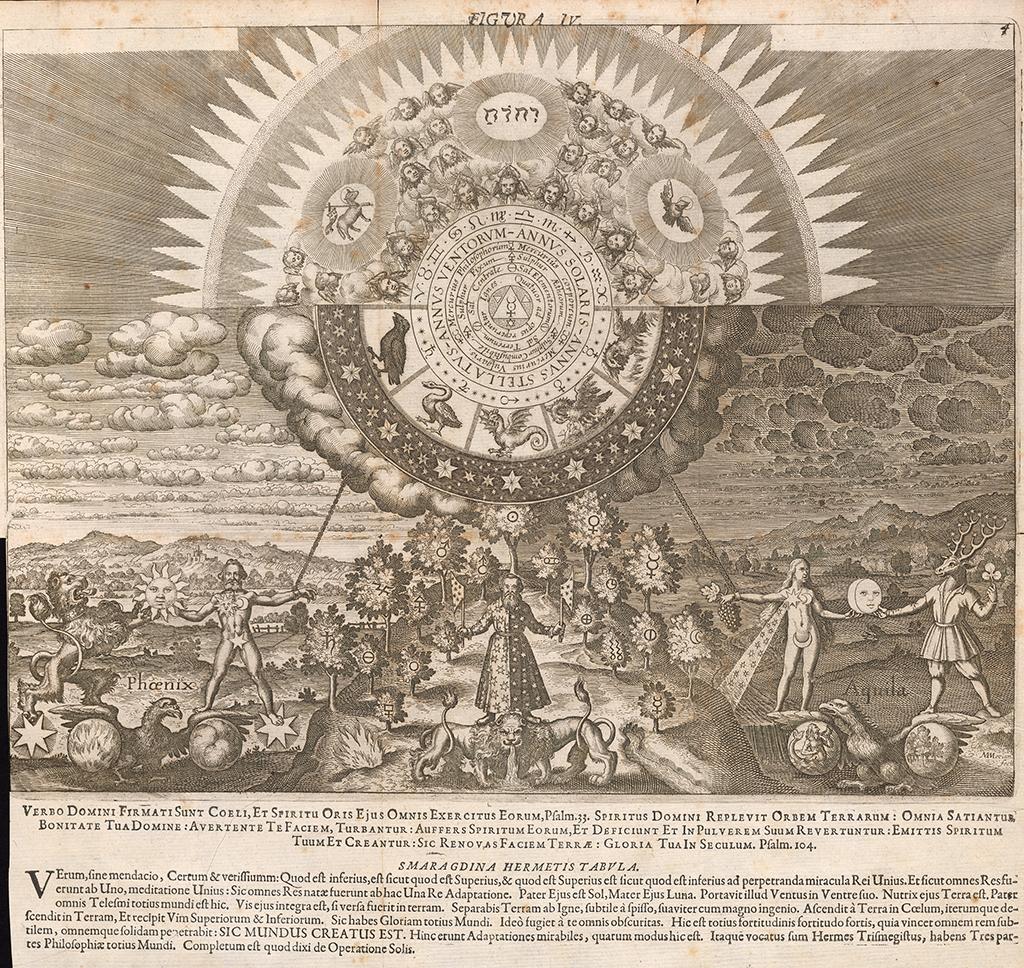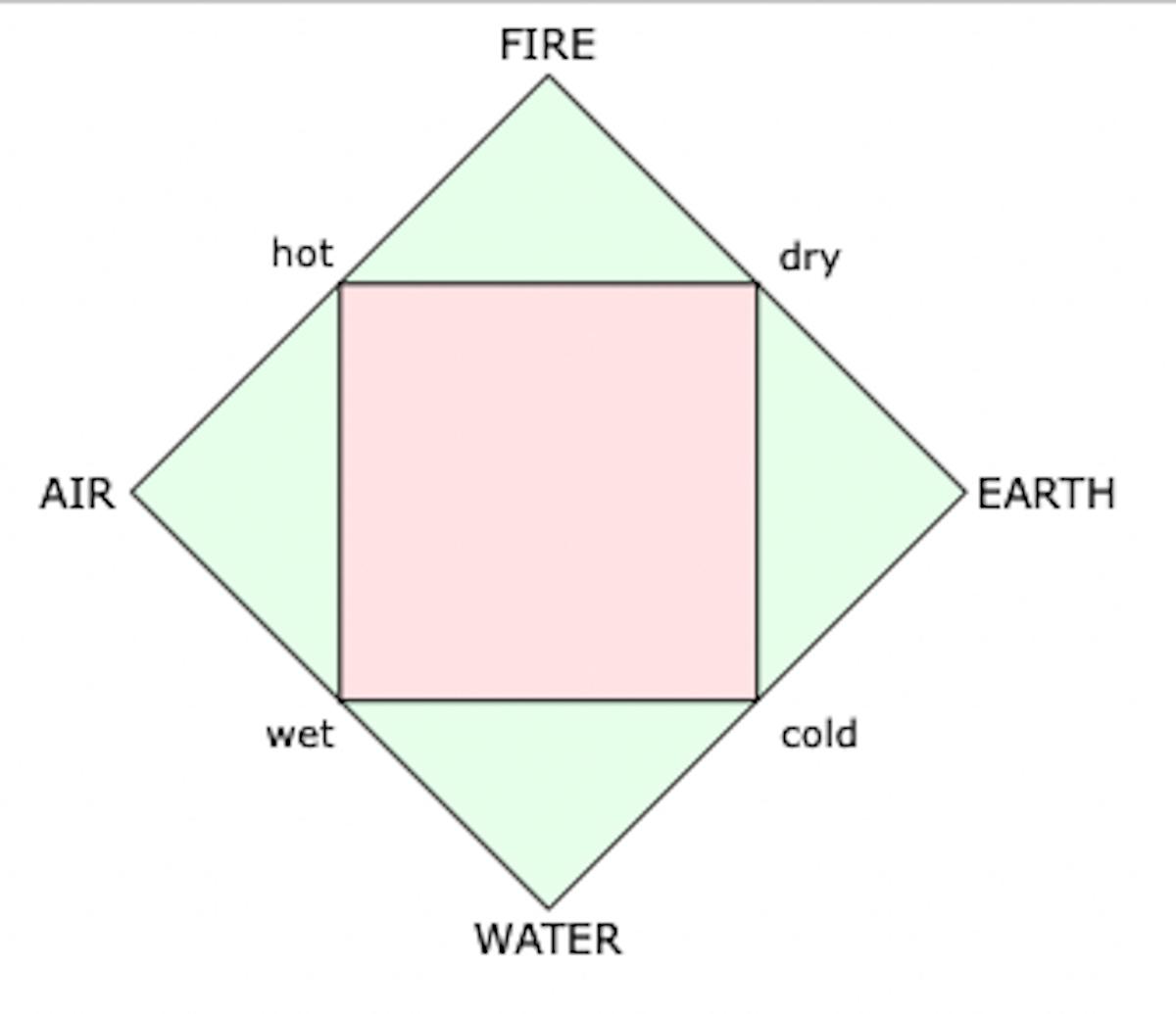The classical elements in alchemy are that of the planet: aer (air), terra (earth), ignis (fire), and aqua (water), with some scholars including a fifth element aether and quintessentia, known in some ancient Tibetan, Indian, and Greek cultures as “void”, representing the balance and unity of all that is. Each of these symbols has greater meanings than their alchemical use, with air representing the life force of all living beings, the earth being associated with the physical body and the senses, fire’s associations with emotions, and water’s link with intuition. These meanings are crucial to each element’s function as they explain their use's spiritual significance in certain alchemical processes. Aether/quintessential, however, can be believed to solely represent universal balance, an element on its own but rarely quantified as such.

Matthäus Merian the Elder, The Microcosm and the Macrocosm from Musaeum Hermeticum, 1678. Engraving
Serving as an arguable transition from the mysticism of religion-based scientific belief into modern science, alchemy bridges the gap between the spiritual and the physical. Although most alchemists sought to combine precious metals into gold to form the philosopher’s stone, an object that is shrouded in mysticism and supposed to grant one eternal youth. This fusing of certain elements to create an entirely new substance serves as the precursor, and the foundation, of modern chemistry. Rooted in the search for ancient wisdom, alchemy became a commonplace and progressively scientific thought in the sixteenth century during the Enlightenment.
Grounded in the transformation of matter, alchemy was assumed to reflect ancient ideas on the mind, body, and spirit, and each of their places in science, mathematics, philosophy, and other areas of academic thought. The three substances that all others consist of according to alchemical thought are known as the tria prima, or the three primes: the soul as sulfur, the spirit as mercury, and the body as salt.

The Three Primes

The Classical five elements
Since alchemy has been practiced from as early as the seventh century, certain alchemical symbols, such as the seven planetary metals, are named after planets due to the coinciding practice of astrology. Since both alchemy and astrology were not only practiced alongside one another but often together, early alchemists believed that each individual planet ruled its own element. This can also be seen in elements outside of this category, such as mercury in the tria prima, which also rules the element quicksilver. The most precious elements, gold and silver, are represented and ruled by the Sun and Moon due to their alchemical significance. These elements, outside of their preciousness and financial value, are arguably two of the materials thought to be used in the fusion necessary to form the legendary Philosopher’s Stone.

The Seven Planetary Elements
To create the Philosopher’s Stone, there was a twelve-step process one had to follow carefully, with each scientific process within it being named after, and ruled by, a Zodiac sign. The Alchemical Magnum Opus is a lengthy and complex process of multiple transformations of substances from solids to vapors, vapors to solids, solids to liquids, then liquids to solids. Although there is no specific order to the magnum opus, alchemists attempted to use it to create the mystical Philosopher’s Stone regardless.

The Squared Circle/Philosopher’s Stone.
Although it originally began as a return to ancient wisdom, then evolved into a quest for a mystical stone, the alchemical process of transmutation arguably serves as the foundation for modern chemistry. Alchemy’s history and uses are occasionally presented as being shrouded in mystery or magic. Still, its processes bridged the gap between the physical and the spiritual, not adhering to a separation of the mind and spirit. At a pivotal moment in world history, as science further developed, alchemy served as a transition from religious-based world beliefs to scientific explanations of existential mysteries. This union of the spirit and the self is rooted in its symbols, processes, and meanings, all of which point to a higher purpose and the desire to live in alignment with it.

Raphael Custos, Conjunction in Steffan Michelspacher’s Cabala, Spiegel der Kunst und Natur in Alchymia, 1663. Engraving,

























![DEl Kathryn Barton [Australian b. 1972] the more than human love , 2025 Acrylic on French linen 78 3/4 x 137 3/4 inches 200 x 350 cm Framed dimensions: 79 7/8 x 139 inches 203 x 353 cm](/sites/default/files/styles/image_5_column/public/ab15211bartonthe-more-human-lovelg.jpg?itok=wW_Qrve3)